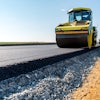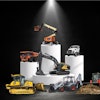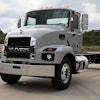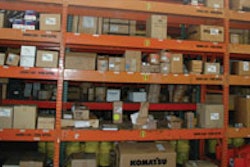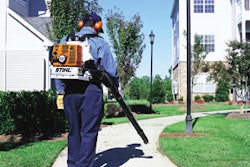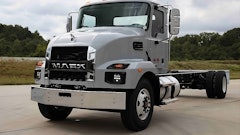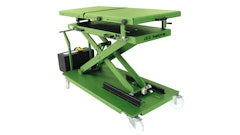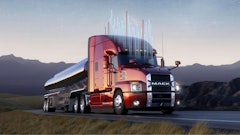Automatic and automated transmissions have become very popular. They often increase productivity, reduce stress on the operators and protect the entire driveline from abuse caused by inexperienced drivers.
The Allison transmission has become a very popular option for vocational on/off-road use. These torque converter transmissions are capable of handling muddy and hilly jobsites, while increasing productivity by eliminating the power interruptions required when shifting a manual transmission. They also minimize costly clutch repair downtime that can be associated with a manual transmission. But there are steps you should take to maximize the investment in your automatic transmission.
Transmission fluid is the "life blood" of any automatic torque converter transmission. "In an automatic transmission, the fluid does considerably more than it does in a manual transmission," says Keith Duner, manager of service technology, Allison. "It is used to transmit power. It is used to actuate and release clutches. It is used to cool and lubricate bearings and friction material within the transmission. So it carries a heavy load."
These multiple demands require specialized fluids and regular maintenance to ensure trouble-free performance. "The selection as well as the maintenance of the fluid is critical to the life of the transmission," says Duner. "It is equal parts selection and long-term maintenance of the fluid."
Transmission fluids are designed to stay in the transmissions for relatively long periods of time. While there are many fluids approved for use in its automatic transmissions, such as DEXRON, fluids that meet the stringent Allison TES-295 specification offer several advantages. One such fluid is TranSynd, which was developed in cooperation with Castrol.
"For off-highway applications or rugged duty, we certainly recommend TES-295 fluid," says Duner. "Its oxidation rate is considerably less. Its ability to handle heat is considerably greater to the extent where, when used as we request, you can actually extend the fluid change interval of the transmission based solely on the fluid."
While TES-295 fluids will extend drain intervals, you still need to perform regular oil and filter changes, plus oil analysis to maximize life of the transmission. These service intervals are predicated on the duty cycle of the application and type of oil used as spelled out in the operator and mechanic manuals.
Oil analysis can also be used to determine drain intervals. You can monitor transmission health by using trend analysis, as well as ensuring the oil falls within safe limits as published in Technicians Guide for Automatic Transmission Fluid, part number GN2055EN. This document is available for purchase via the Allison Internet site (www.allisontransmission.com).
Keep it cool
The amount of heat generated really depends on the application. Off-road applications tend to generate more heat. "An on/off- road vehicle equipped with one of our transmissions has a different calibration than one that is a pure on-highway duty cycle," says Duner. "As a result, we control the amount of time that we spend in lock-up clutch vs. converter mode separately.
"Converter mode is great for traction, but it is a heat generator," he continues. "So we monitor that and apply it differently in an off-highway application."
To keep everything operating as designed, you need to properly maintain the cooling system, which is typically shared with the engine. This is particularly important with trucks that run off road.
"You are in a high dust, high dirt environment, which raises the likelihood of the coolant system being plugged and clogged with foreign debris and material," says Duner. "So getting in there with your radiator comb and making sure that your fins are clear and accessible is a reasonable thing."
Watch for coolant leaks
"It is not completely uncommon to see cooler failures that result in glycol or coolant contamination of the transmission fluid," says Duner. "What can happen is that fluid - whether it be glycol or some other coolant - can actually turn to steam. It attacks the bonding of the friction material to the steel backing plate, which makes up a friction plate.
"So in a glycol- or coolant-related failure, it is fairly common to see sheet pieces of friction material sloughing off the clutch plates as opposed to the typical, more gradual wear you would see by virtue of normal use," says Duner. The coolant can also reduce the frictional capacity of drive plates as a result of surface film or impregnation.
This emphasizes the importance of an oil analysis program. "It gives you an indication of that type of event," says Duner. Then you can take the appropriate steps to minimize the impact on the transmission.
Preventive checksThere are visual checks you can routinely perform to prevent breakdowns. "All of our transmissions ship with a breather, a vent on the main case that compensates for the change in temperature and the expansion and contraction of the fluid," says Duner. "That needs to remain clean and clear. In some applications, that can be something of a challenge."
Off-road operation also creates more opportunity for driveline damage from rock hits. "Dented, worn or out-of-phase slip joints or worn U-joints are quite prevalent in that environment," says Duner. "Because our transmissions run overdrive ratios, we do get some fairly reasonable speeds. Those driveline speeds amplify problems resulting from phasing or out of balance."
Many drivelines have weights welded on. If a rock knocks a weight off, the driver will start to experience vibration that was not there before. "Certainly a good place to start looking is the condition of the driveshaft," Duner advises.
Other things to look for include loose bolts or fluid leaks and frayed or worn wires in the wiring harness.
The automated alternative
Automated transmissions are also prevalent in the market. Unlike the torque-converter automatic, the automated transmission is based on a manual transmission. "It is essentially a manual transmission that is automated," says Jim Whitmer, Eaton. "The stick is replaced by electric motors which select gears and rails."
Shifts are made similar to a manual transmission, except the driver has been removed from the process. With a manual transmission, you start by pushing in the clutch to interrupt the torque. "The AutoShift does it by sending a command to the engine to de-fuel. When the engine de-fuels, it essentially breaks the torque so the AutoShift can move the shift lever into neutral," says Whitmer. "If we are upshifting, we have to let the engine speed come down until it gets to synchronous. It then clicks into the next gear. It does all of that automatically and relatively quick."
When used in the right applications, this prevents damage from inexperienced operators. "We notice that any of the parts that can wear out from improper range shifting or improper gear shifting just are not an issue," says Whitmer. "You just do not have those worn out items."
The transmissions are available in 10- and 18-speed versions. Whitmer says this provides a wider gear ratio range than typical automatics. "You have those smaller gear steps," he explains. "You can put the engine in its fuel band a lot better."
But not all off-road conditions favor the use of the AutoShift. In certain applications, where you have to start on a steep grade or on some muddy or sandy jobsites, you should get engineering approval first. This is due to the nature of the shifting. If the truck comes to a stop faster than the engine speed can drop when de-fueled, the transmission may not be able to shift to the next gear.
Maintenance of the AutoShift is rather straightforward. It uses the same oil as the RoadRanger manual transmissions. "Because we basically took a manual transmission that has been out there and automated it, there is parts availability," says Whitmer. "There are mechanics who know how to work on them.
"It is very modular in design," he continues. "We can pull off any of the automated components - ECUs, electric shift modules - and replace them from the outside. You don't have to go into the box."
Whitmer adds that when it is time for a rebuild, the AutoShift is less expensive than a typical torque converter automatic.
Warning Signs of Coolant Contamination
Oil analysis results will help you identify coolant leaks into the transmission oil, but there are other warning signs you should watch for between oil sampling. Allison Transmission lists conditions that indicate possible water and/or glycol contamination in the transmission oil:
- Rust or pitted transmission parts
- Oil spewing out of the transmission breather
- Oil in radiator
- Gaskets blistered or wrinkled in uncompressed areas
- Oil appearance - water present in oil, when dispersed, is a cloudy or gray, pink or strawberry color
- Steam from the breather


